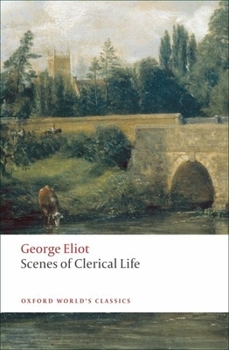Book Overview
'the only true knowledge of our fellow-man is that which enables us to feel with him' George Eliot's first published work consisted of three short novellas: 'The Sad Fortunes of the Reverend Amos... This description may be from another edition of this product.
Format:Paperback
Language:English
ISBN:0199552606
ISBN13:9780199552603
Release Date:August 2009
Publisher:Oxford Paperbacks
Length:336 Pages
Weight:2.55 lbs.
Dimensions:0.7" x 7.6" x 5.0"
Customer Reviews
3 ratings
a neglected gem
Published by Thriftbooks.com User , 15 years ago
Scenes of Clerical Life by George Eliot. Published by MobileReference (mobi). If you want realism get this ebook. It's a fabulous introduction to Eliot, as well as one of her best works.
George Eliot's first published fictional work is a neglected gem by the literary genius
Published by Thriftbooks.com User , 17 years ago
George Eliot (Mary Ann Evans) was born in Warwickshire in 1819. Her father was an estate manager and farmer. Little Mary Ann knew life in rural England. She would make rural Britain during the time of the industrial revolution her main fictional focus. She is the author of great classics "Middlemarch" "Adam Bede" "The Mill on the Floss" "Romola and "Daniel Deronda/" Prior to the publication of these classics there is the charming and touching work "Scenes of a Clerical Life." Mary Ann was living without benefit of clergy with the author/scientist/man of letters George Henry Lewes who couldn't divorce his mad wife to mary the homely but brilliant Mary Ann (she spoke seven languages and had written widely on biblical criticism, science, book reviews and essays of erudition and wit). Lewes suggested she try her hand at fiction. The result is this collection of three stories which was published monthly in the liberal "Westminster Review" owned by the Blackwood Family in 1857. It was later published in book form under the pen name of "George Eliot". Charles Dickens was the only critic who correctly observed that these stories had to have been written by a woman. The three tales are: 1. The Sad Fortunes of the Rev. Amos Barton-The setting for this story as for the other two is the mythical Midlands town of Milby. Barton is an a very average cleryman who is not well liked by his parishoners. He is in dire poverty supporting several children and a sickly wife Millie. When Mrs. Barton dies we see how the church folks support Barton in his grief. The story is short and touching. 2. Mr. Gilfil's Love Story. This second clergyman in the trilogy of tales is a kindhearted old minister of the gospel. Eliot takes us back to 1788 to the story of his lost love for the beautiful Caterina. Caterina was born in Italy to an opera singer. When he died she was taken to England to be raised by a rich family. Her chief purpose is to sing for the family. She falls in love with a wealthy aristocratic soldier who dies. Mr. Gilfil who has loved her all along then marries Caterina. She herself dies in childbirth. Despite his grief Mr. Gilfil ministers for many years to the people in Milby. This tale is a tragic story of love and loss and redemptive service to other people. Eliot told realistic stories about ordinary people. She is the a novelist of great psychological depth as well as able to puncture the balloons of hypocrisy always afloat in human society. Janet's Repentance. Janet is a wealthy woman who is also a battered wife. She is married to Mr Dempster who is a wealthy powerful attorney. Dempster is also an incorrigble drunk and wife beater. One night he cast Janet out into the cold. She is rescued by kind friends and the saintly Rev. Mr. Tryan. We see Janet rescued from despair to a life of useful service. We also overhear debates by the townspeople (serving as a Greek chorus in Eliot's works) commenting on the theological controversies of the day. These three s
Eliot's first is still a landmark
Published by Thriftbooks.com User , 18 years ago
Eliot's first work here is still surprising in its form, its message, and its outlook. Eschewing the romantic elements of the early-mid 19th century, Eliot embraced (if not practically invented) realism--not necessarily that real life should constitute all texts, but that real people should inhabit them, changing characters, three-dimensional people with which the reader is nearly forced to sympathize. Eliot's narrators are constantly, though never tediously, beckoning our sympathies to these people--drab, regular, nondescript characters which still hold our fervent attention to the end. I will not speak of the plots here, for you can look elsewhere for that. Suffice it to say that Eliot is the only feminist I will ever read. Her descriptions, always important and vital to the meaning of the story, are utterly incredible. This book is more like poetry in this regard--its imagery, its vibrancy. If you buy this book, think of some of these questions: -Why is it called "The Sad Fortunes of Amos Barton" and not "...of Milly Barton"? -Always keep in mind the muddling of characters and concepts. Are there are any ideal characters in this book, or are nearly all characters both execrable and sympathetic at the same time? If there is an ideal character, why would Eliot do this? (Milly) -When does Janet make her first appearance in her story? Why? That's enough. This book isn't read enough. It's a fabulous introduction to Eliot, as well as one of her best works. Her scope here is much more focused than than of her other works, though not to disparage those too much...it's less than 400 pages, whereas Middlemarch is around 1000! Read this, then pick up Middlemarch. If you want realism, and if you think Henry James isn't very readable, pick up this book.






